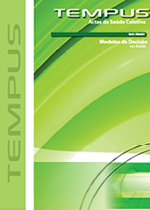Abstract
The Virtual Reality (VR) allows its users to experience a sense of being immersed in synthetic 3D scenarios generated by computer graphics. The so-called Virtual Environments (VEs) based on RV can be applied to medical education, enabling: repetitive training and the development of psychomotor skills in surgical procedures without compromising real patients. Surgical simulators that feature Dynamic Virtual Patients (VPs), that is, reacts physiologically to interventions and medical decisions made during the training. These systems present more realism while it offers the possibility of varying clinical cases. This work has as main objective to discuss important issues of modeling the hemodynamic performance of a VP, specifically to simulate blood pressure values (both sistolic and diastolic variables). The model of a VP is presented as result as well as is presented an architecture for its integration to simulators based on VR.References
Moraes, R.M; Machado, L.S. Simultaneous assessment of teams in collaborative virtual environments using Fuzzy Naive Bayes. 2013 Joint IFSA World Congress and NAFIPS Annual Meeting (IFSA/NAFIPS), p. 1343–1348, 2013.
Paiva, P.V.F.; Machado, L.S, Oliveira, J.C. A peer-to-peer Multicast Architecture for Supporting Collaborative Virtual Environments (CVEs) in Medicine. In: Proceedings of XIV Symposium on Virtual and Augmented Reality. Niterói/RJ, Brasil, 2012, p. 165-173.
Paiva, P.V.F.; Um Ambiente Virtual Colaborativo para Educação Cirúrgica. [dissertação] [internet] Universidade Federal da Paraíba; 2003. [acesso em 20 de jan. 2015]. Disponível em: http://tede.biblioteca.ufpb.br/handle/tede/6555.
Robert Kleinert; Roger Wahba; De-Hua Chang et. al. 3D Immersive Patient Simulators and Their Impact on Learning Success: A Thematic Review. Journal of Medical Internet Research. 2015, 8;17(4):e91. doi: 10.2196/jmir.3492.
Soares, R.A.S Modelo de Suporte à Decisão Aplicado ao Atendimento das Vítimas de Acidentes de Trânsito na Cidade de João Pessoa. [dissertação] [internet] Universidade Federal da Paraíba; 2003. [acesso em 29 de dez. 2014]. Disponível em: http://bdtd.biblioteca.ufpb.br/tde_busca/arquivo.php?codArquivo=2381.
Zadeh, L.A. Fuzzy Sets. Information Control. 1965, 8(3), 338-353.
Silva Neto WV, Azevedo GS, Coelho FO, Netto EM, Ladeia AM. Evaluation of Hemodynamic Variations during Anesthetic Induction in Treated Hypertensive Patients. Rev. Bras. Anestesiol. 2008; 58(4): 330-341.
Smeltzer SC, Bare BG. Brunner & Suddarth: tratado de enfermagem médico-cirúrgica. 12 ed. Rio de Janeiro: Guanabara Koogan, 2012.
Sabiston, D.C. Townsend, C.M. Tratado de Cirurgia. A Base Biológica da
Prática Cirúrgica Moderna. Rio de Janeiro : Elsevier, 2010; 1(18):411-413.
Silverthorn, DU. Fisiologia Humana: uma abordagem integrada. Porto Alegre: Artmed, 2010.
Costanzo, LS. Fisiologia. 5ª ed. Rio de Janeiro: Elsevier, 2014.
Sociedade Brasileira de Cardiologia, Sociedade Brasileira de Hipertensão. VI Diretrizes Brasileiras de Hipertensao Arterial. Arq Bras Cardiol 2010; 95(Supl. 1):1-51.
Massad, E. et al. Fuzzy logic in action: Applications in epidemiology and beyond. Studies in Fuzziness and Soft Computing, vol. 232, Springer; 2008.
Moraes, R.M; Machado, L.S. Fuzzy Continuous Evaluation in Training Systems Based on Virtual Reality. In: Proc. of 2009 IFSA World Congress, Lisboa, p. 102-107, 2009.
Mamdani, E.H. Application of fuzzy algorithms for control of simple dynamics plant. Proceedings of the Institution of Electrical Engineers, 1974; 121(12):1585-1588.
Viciana-abad; Reyes-lecuona, A. Patient modelling using expert systems for medical training simulations based on virtual reality. Anais d 7th International Conference on Virtual Reality, VRIC - LAVAL VIRTUAL, 2005.
Posselt E.L., Frozza, R.; Molz, R.F. INFUZZY: Ferramenta para Desenvolvimento de Aplicações de Sistemas Difusos. Revista Brasileira de Computação Aplicada, Passo Fundo, Abril, 2015; 7(1): 42-52.
Dev P, Heinrichs WL, Youngblood P, Kung S, Cheng R, Kusumoto L, Hendrick A. Virtual patient model for multi-person virtual medical environments. AMIA Annu Symp Proc. 2007, Oct, 11:181-5.
Dev P, Heinrichs WL, Youngblood P. CliniSpace™: A Multiperson 3D Online Immersive Training Environment Accessible through a Browser. Stud Health Technol Inform. 2011;163:173-9.
Caudell TP; Summers KL; Holten J; Hakamata T; Mowafi M; Jacobs J; Lozanoff BK; Lozanoff S; Wilks D; Keep MF; Saiki S; Alverson D, Virtual patient simulator for distributed collaborative medical education. Anat Rec B New Anat. 2003, Jan; 270(1):23-9.
Taekman, J.M. et al. 3DiTeams – Healthcare team training in a virtual environment. The Journal of the Society for Simulation in Healthcare, 2008, 3(5). p. 112.
Cecil, J. et al Collaborative virtual environments for orthopedic surgery. 2013 IEEE International Conference on Automation Science and Engineering (CASE), p.133–137, 2013. doi:10.1109/CoASE.2013.6654045.
Paiva, P.V.F.; Machado, L.S.; Valença, A.M.G. A Virtual Environment for Training and Assessment of Surgical Teams. In: Anais do XV Symposium on Virtual and Augmented Reality 2013. Cuiabá/MT - Brazil. 2013; (15):1, 17-26. doi: 10.1109/SVR.2013.22.
Paiva, P.V.F.; Machado, L.S.; Batista, T.V.V. A Collaborative and Immersive VR Simulator for Education and Assessment of Surgical Teams. In: Anais do XVII Symposium on Virtual and Augmented Reality 2015. São Paulo/SP - Brazil. no prelo.
S. Singh e J. E. Smith. Cardiovascular changes after the three stages of nasotracheal intubation. British Journal of Anaesthesia (BJA). 2003; 91(5): 667-671. doi: 10.1093/bja/aeg240.
A Tempus garante critérios rigorosos, por meio de avaliação sistemática. Os autores se responsabilizam pela veracidade e ineditismo do trabalho cabendo a eles a cessão de direitos de publicação à revista. A confiabilidade dos conteúdos e a marca própria de apresentação tem como objetivo uma comunicação personalizada, adaptada aos padrões da revista, na medida em que adota critérios de excelência exigidos por seus usuários e especialistas, considerando os rigores da comunicação científica. Os autores devem especificar sua contribuição individual na concepção, delineamento, execução do trabalho, análise ou interpretação dos dados, redação e aprovação final do manuscrito. Incluir Fontes de financiamento e de apoio logístico das pesquisas. Ao final da submissão do artigo, os autores devem enviar uma declaração de cessão de direitos de publicação à Revista TEMPUS , assinada e no formato PDF (Portable Document Format ): Modelo da declaração de cessão de direitos.
